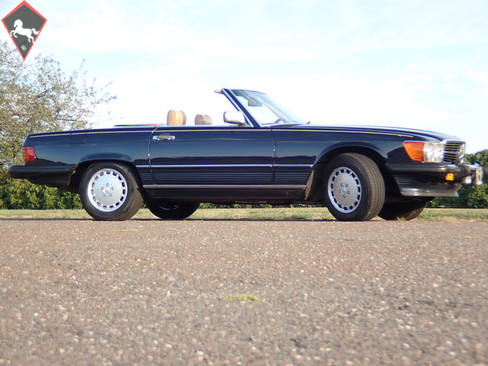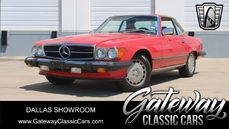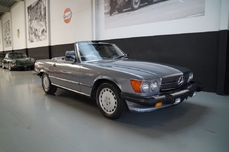Mercedes-Benz 560SL w107 1988
General description :
1988 Mercedes Benz 560 SL
This is a 4 owner car that has spent all of it's time in CT. Originally purchased from the Carriage House in New London, her owner was in Niantic. She then moved to her second owner in South Windsor and her third owner moved her to West Hartford. The current owner is also in West Hartford.
After enjoying her for several years, it's now time to move her on to a new home.
The 560 is a 5.6L V8 that puts out a little over 220 HP and close 280 lb.ft of torque.
This one has just over 124,000 miles but runs very strong. The inside name for these when they were on the drawing board was the Panzerwagen as they were built very strong, and durable like a tank.
This one is painted in Midnight Blue (which has been resprayed) over a Palomino leather interior, which has also been "resprayed"... The front seats have been re-dyed in original color.
From the factory these came with power steering, power disc brakes (F&R), AC, cruise control, driver side air bag, power windows, central locking mechanism, to name a few. Additional underhood codes include: 262-Spoiler delete, 519-Becker Mexico Radio, 551 Anti-Theft warning and 581-Automatic Climate Control.
Currently the AC/Fan are not working but will be fixed before it is purchased.
The interior shows some wear from the 124K miles but the issues aren't insurrmountable by someone with a little shade-tree mechanic experience, filling and dying again. The paint looks beautiful, especially from about 10 feet away, as one gets closer one can see the small nicks and scratches, most of which are on the back end, most probably from someone having a hard time installing the hard top.
The hard top IS included however, it was not at the location when taking these photos. More to follow.
Any engine or vehicle with over 100,000 miles can be expected to have a couple leaks and this one is no exception, nothing major, just some gasket seepage on the lower end.
Recent work done includes the steering rag joint, brakes, the rims have been refinished and a general tune up.
The under carriage is rather solid, aside from one very small spot of corrosion on the right side pinch weld. Two of the four jack points also show some corrosion around them but not full on rot through.
Overall, this is a great weekend cruiser, solid driver. She won't be winning any shows but she will win admiration from those who see her drive by.
She can be had for roughly a 6th of what she sold off the dealer lot for in 1988. Back then her sticker price as seen on the original window sticker was $62,430.
Asking price is $11,000.
Any questions, for many more photos and video, to schedule a time to see her in person or to make an offer, please don't hesitate to contact me.
Thank you for the interest.
Document description :
Registrations
1988 Mercedes-Benz 560SL w107 is listed for sale on ClassicDigest in Middletown by David Brill for $11000.
Car Facts
Car type : Car Make : Mercedes-Benz Model : 560SL w107 Engine size : 5.6 Model Year : 1988 Sub type : Convertible Color : Blue Color type : Nonmetallic Condition : 3 Location : East Windsor, CT USA Vehicle Registration : Historic
11000 $
Seller Information
AutoArcheologist
David Brill
United States
18603981732
Yes
133 Ballfall Rd Middletown
David Brill
United States
18603981732
Yes
133 Ballfall Rd Middletown
People who viewed this Mercedes-Benz 560SL w107 also viewed similar Mercedes-Benz listed at ClassicDigest
Other cars listed for sale by this dealer
About Mercedes-Benz
In the annals of automotive history, the journey of Mercedes-Benz is a tale that unfolds with the ingenuity of its founding pioneers. In the year 1886, Karl Benz crafted the Benz Patent Motorwagen, a creation that would go down in history as the world's inaugural automobile. Unbeknownst to him, this moment marked the genesis of what would evolve into the most illustrious premium car manufacturer globally. The financial underpinning of this pioneering venture, interestingly, was provided by Karl Benz's wife, Bertha Benz, demonstrating a remarkable partnership that would set the tone for Mercedes-Benz's legacy.A parallel narrative emerged not far away, as Daimler-Motoren-Gesellschaft, founded by Gottlieb Daimler and Wilhelm Maybach, entered the scene. In 1901, they unveiled their automobile under the now-famous moniker "Mercedes," meaning "godsend" in Spanish. This name was bestowed upon the car at the behest of Emil Jellinek's daughter, the distributor for Daimler-Motoren-Gesellschaft. The wheels of innovation were set in motion.
Fast forward to 1926, a pivotal year that witnessed the merger of Daimler with Benz & Cie., culminating in the birth of Daimler-Benz. The amalgamation saw the adoption of "Mercedes-Benz" as the distinguished trademark for their automobiles, fusing the legacies of two visionary entities into one.
Contrary to perceptions of conservatism, the trajectory of Daimler-Benz unfolds as a chronicle of industry firsts. From the introduction of the honeycomb radiator to the float carburetor, and the pioneering implementation of four-wheel brakes in 1924, Daimler-Benz consistently pushed the boundaries of automotive innovation. The diesel-powered Mercedes-Benz 260 D in 1936 marked the inception of diesel engines in passenger cars. The iconic Mercedes-Benz 300SL Gullwing made history as the first car with direct fuel injection, albeit the Gutbrod's tiny 2-stroke engine can claim precedence.
Safety innovations became a hallmark, with Béla Barényi's patented safety cell design in the "Ponton"-models in 1951, featuring front and rear crumple zones. The W116 450SEL 6.9 saw the introduction of the Anti-Lock Brake system (ABS), another pioneering safety feature. From the first production airbags and beyond, the legacy of "firsts" continued to be etched into the fabric of Daimler-Benz.
Over its centennial journey, Mercedes-Benz has not merely produced cars but has sculpted automotive icons. The SSKL, 710 SSK Trossi Roadster, 770K Grosser, 540K Spezial Roadster, 300SL Gullwing, w100 600 Pullman, w111 280SE 3.5 Flachkühler, w113 230SL Pagoda, w109 300 SEL 6.3, and w201 2.3-16 Cosworth stand testament to the brand's commitment to engineering excellence.
The roaring Silver Arrows, or "Silberpfeile," including the W 25, W 125, W154, W165, and W196, created a legacy of dominance on the racetrack. These machines were not merely cars; they were expressions of precision, speed, and an indomitable spirit that left their competitors in the dust.
As Mercedes-Benz marches into the future, it does so not just as an automaker but as a custodian of a legacy, a torchbearer of innovation, and a beacon of automotive excellence. The road ahead is sure to witness the continued fusion of cutting-edge technology, timeless design, and an unwavering commitment to setting new standards in the world of automobiles.
One luminary figure who left an indelible mark was Béla Barényi, often heralded as the "father of passive safety" for his pioneering work in safety engineering. His patented safety cell design, featuring front and rear crumple zones, became a hallmark of Mercedes-Benz's commitment to occupant safety, setting new standards that reverberated throughout the automotive world.
Moving through the chronicles, the collaborative genius of Wilhelm Maybach, alongside Gottlieb Daimler, laid the foundation for Daimler-Motoren-Gesellschaft. Their innovations not only birthed the first Mercedes but established a culture of relentless pursuit of technological excellence that remains integral to Mercedes-Benz's DNA.
In the post-merger era of 1926, Ferdinand Porsche emerged as a prominent figure within Mercedes-Benz. His work on the Mercedes-Benz S-Type, a supercharged race car, garnered acclaim and set the stage for a legacy that extended far beyond the marque. Porsche's impact would later extend to his eponymous company, but his influence at Mercedes-Benz during those formative years was pivotal.
As the 20th century progressed, the legendary Rudolf Uhlenhaut emerged as a key figure. Uhlenhaut, an accomplished engineer and the driving force behind the iconic Silver Arrows, played a crucial role in Mercedes-Benz's dominance in motorsports. His engineering prowess and attention to detail were instrumental in creating some of the most formidable racing cars of the era.
In the latter half of the century, figures like Bruno Sacco, the head of design at Mercedes-Benz from 1975 to 1999, left an indelible imprint on the brand's aesthetic identity. Sacco's design philosophy, characterized by clean lines and timeless elegance, shaped iconic models like the W126 S-Class and the W201 190E, solidifying Mercedes-Benz's reputation for luxury and sophistication.
The narrative would be incomplete without acknowledging the contributions of engineers like Hans Scherenberg, whose leadership in the 1970s ushered in a new era of technological innovation at Mercedes-Benz. Scherenberg's tenure saw the development of groundbreaking technologies, including the Anti-Lock Brake system (ABS) and the introduction of airbags in production cars.


































